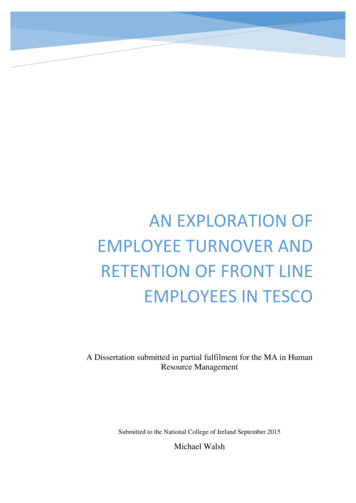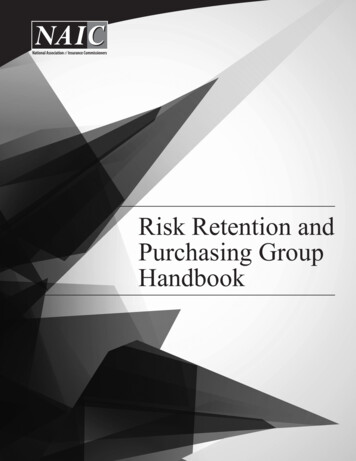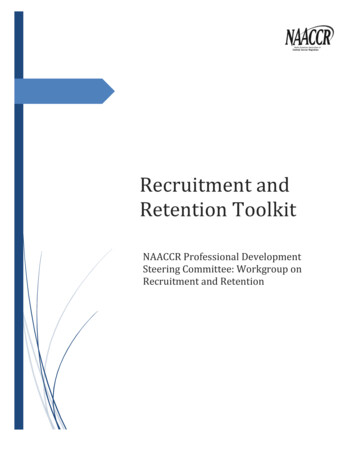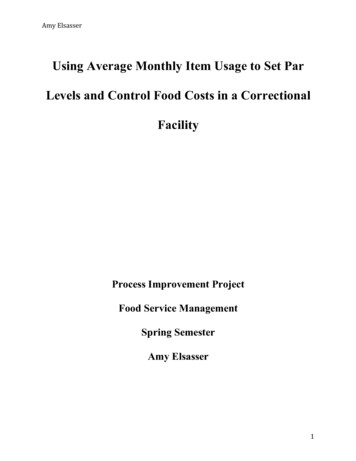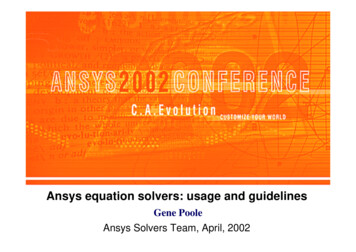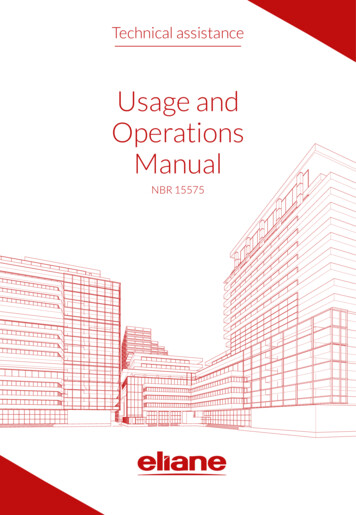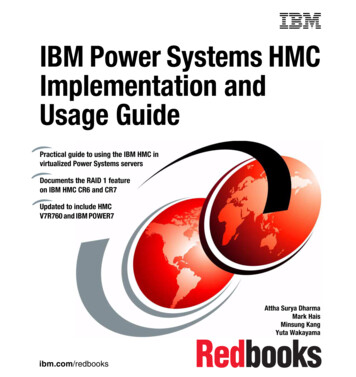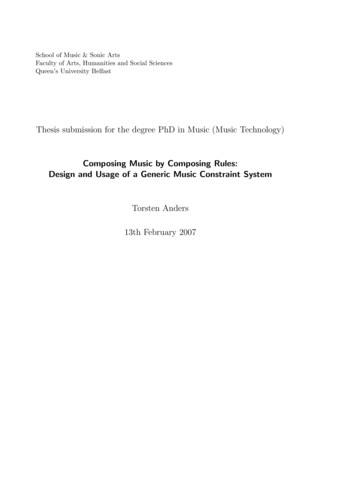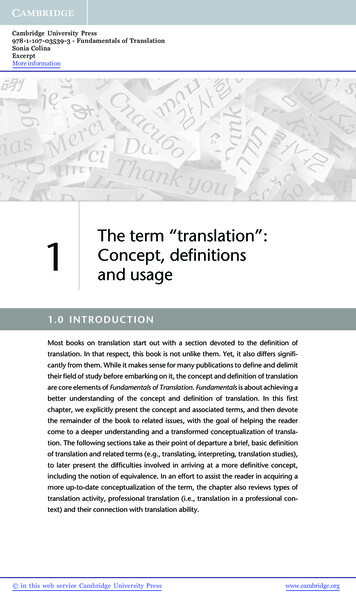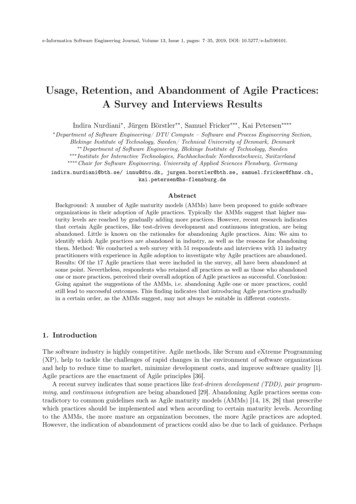
Transcription
e-Informatica Software Engineering Journal, Volume 13, Issue 1, pages: 7–35, 2019, DOI: 10.5277/e-Inf190101.Usage, Retention, and Abandonment of Agile Practices:A Survey and Interviews ResultsIndira Nurdiani , Jürgen Börstler , Samuel Fricker , Kai Petersen Department of Software Engineering/ DTU Compute – Software and Process Engineering Section,Blekinge Institute of Technology, Sweden/ Technical University of Denmark, Denmark Department of Software Engineering, Blekinge Institute of Technology, Sweden Institute for Interactive Technologies, Fachhochschule Nordwestschweiz, Switzerland Chair for Software Engineering, University of Applied Sciences Flensburg, Germanyindira.nurdiani@bth.se/ innu@dtu.dk, jurgen.borstler@bth.se, eAbstractBackground: A number of Agile maturity models (AMMs) have been proposed to guide softwareorganizations in their adoption of Agile practices. Typically the AMMs suggest that higher maturity levels are reached by gradually adding more practices. However, recent research indicatesthat certain Agile practices, like test-driven development and continuous integration, are beingabandoned. Little is known on the rationales for abandoning Agile practices. Aim: We aim toidentify which Agile practices are abandoned in industry, as well as the reasons for abandoningthem. Method: We conducted a web survey with 51 respondents and interviews with 11 industrypractitioners with experience in Agile adoption to investigate why Agile practices are abandoned.Results: Of the 17 Agile practices that were included in the survey, all have been abandoned atsome point. Nevertheless, respondents who retained all practices as well as those who abandonedone or more practices, perceived their overall adoption of Agile practices as successful. Conclusion:Going against the suggestions of the AMMs, i.e. abandoning Agile one or more practices, couldstill lead to successful outcomes. This finding indicates that introducing Agile practices graduallyin a certain order, as the AMMs suggest, may not always be suitable in different contexts.1. IntroductionThe software industry is highly competitive. Agile methods, like Scrum and eXtreme Programming(XP), help to tackle the challenges of rapid changes in the environment of software organizationsand help to reduce time to market, minimize development costs, and improve software quality [1].Agile practices are the enactment of Agile principles [36].A recent survey indicates that some practices like test-driven development (TDD), pair programming, and continuous integration are being abandoned [29]. Abandoning Agile practices seems contradictory to common guidelines such as Agile maturity models (AMMs) [14, 18, 28] that prescribewhich practices should be implemented and when according to certain maturity levels. Accordingto the AMMs, the more mature an organization becomes, the more Agile practices are adopted.However, the indication of abandonment of practices could also be due to lack of guidance. Perhaps
2Indira Nurdiani, Jürgen Börstler, Samuel Fricker, Kai Petersensuch practices were not introduced at the right time, given the maturity of the software developmentteams or organization, because Agile practices dependencies are not well known.Currently, we do not know why Agile practices are abandoned and how this impacts the overallsuccess of Agile implementations. Without such information, we are unable to evaluate the suitabilityof AMMs in industry. As the first step towards evaluating the suitability of the AMMs is to betterunderstand the usage and retention of Agile practices, and identify the rationales for abandoningAgile practices.In this study, we aim to identify the rate of usage of Agile practices, their retention, and therationales for their abandonment. To achieve our aim, we conducted a web survey and 11 interviewswith industry practitioners with experience in Agile.The remainder of the paper is structured as follows: Section 2 presents related work. Section 3presents the research questions and survey design. Section 4 presents the results and analysis of thesurvey. Section 5 discusses the results and Section 6 summarizes and concludes the paper.2. Background and Related Work2.1. BackgroundAccording Schweigert et al., there are approximately 40 AMMs proposed by academia and industryconsultants [25]. Many AMMs usually associate a number of Agile practices with a maturity level[11, 25]. Practices are introduced gradually. As a team or organization becomes more mature, moreAgile practices are adopted [11]. An overview over three typical AMMs is provided in Table 1.Table 1. Allocation of Agile practices to maturity levels in three AMMs.Sidky et al. [28]Patel & Ramachandran [18]Nawrocki et al. [14]ContextAgile practice adoption basedon a measurement indexAgile practice adoption based onCMM(I)Adoption of XP based onother maturity modelsLevel 1On-site customer, collaborative planning, coding standardTracking progress, continuousdelivery——tracking progress, on-site customer,planning game, TDDLevel 3F2F meeting, continuous integration, self-organizing teamLevel 4Daily meeting (stand up meeting), user stories, frequent releasesTDD, pair programmingRefactoring, pair programming, continuous integration, TDD, coding standard, collective ownershipSelf organizing team, 40 h weekPlanning game, collaboratingcustomer (on-site customer),user stories, metaphorsPair programming, codingstandard, collective ownership, continuous integrationSimplicity (Simple design),on-site customerLevel 2Level 5Focus on continuous improvement—The idea of adding more Agile practices as a team or organizations becomes more mature seemscontradictory to current empirical studies that show that Agile practices like TDD, pair-programming,and continuous integration are abandoned [29]. This raises a question regarding the suitability ofAMMs for industry, particularly when the AMMs do not provide rationales for the mapping of Agilepractices to maturity models. Critics of the AMMs indicate that the AMMs are not fit for industryuse [26] and that their recommendations are contradictory [11, 17]. In this study, we aim to evaluatethe suitability of AMMs by investigating the usage and abandonment of Agile practices in industrythrough a survey and a series of interviews.
Usage, Retention, and Abandonment of Agile Practices: A Survey and Interviews Results32.2. Related WorkKurapati et al. [10] performed a survey to identify commonly used Agile practices at project andorganization levels. Their results show that the most commonly used practices both at project andorganization levels include stand-up meeting, sprint and iteration, collective ownership, and trackingprogress. Less common practices both at project and organization levels include simple design, TDD,pair-programming, and planning game. One practice that is rarely practiced both at project andorganization levels is metaphor. It is also interesting to highlight that the use of metaphors reportedby Kurapati et al. turns out differently from Murphy et al.’s [13].Kropp et al. [8] conducted a survey as part of Swiss Agile Study 2014. They distinguished threetypes of practices: technical, collaborative, and advanced practices. Technical practices include refactoring, TDD, and coding standards. Collaborative practices include on-site customer, daily stand-up,and pair programming. Advanced practices are kanban pull-system, acceptance TDD, and BehaviourDriven Development (BDD). Their results show that more experienced practitioners implementconsiderably more practices compared to less experienced ones. Furthermore, less experienced practitioners implement primarily technical practices, meanwhile more experienced ones implement morecollaborative practices. It is worth noting in this study metaphors is not included in the survey,unlike the previous survey by Kurapati et al.[10].The two surveys described above, i.e. [10] and [8], report the results of Agile practice usage fromone single calendar year. They do not capture whether the practices are continuously used or not.Murphy et al. [13] reported results of five annual surveys internal to Microsoft over the courseof six years. Their results show that practices like code reviews, metaphors, and retrospective are increasing in their adoption. Meanwhile, certain practices like unit testing, TDD and pair programmingare decreasing in their adoption [13, Figure 4, p.79].VersionOne also conducts annual state of Agile surveys. We took the results from the annualsurvey over the past five years (2013 – 2017) and created a figure that presents the trend of theusage of some Agile practice [31, 32, 33, 34, 35] in Figure 1. The results of the annual surveysindicate that the use of Agile practices is fluctuating over the past five years, see Figure 1.100%90%80%70%Daily Standup60%Iteration DCont. Integration30%Pair programming20%10%0%20132014201520162017Figure 1. Fluctuation of Agile practice usage from Version One’s State of Agile 2013 – 2017[31, 32, 33, 34, 35]. The practices shown in the figure are for exemplification and the ones consistentlyreported across the annual surveys.The surveys reported by Murphy et al. [13] and VersionOne [31, 32, 33, 34, 35] capture theincrease and decrease of Agile practices usage over the years. However, the increase of some Agilepractices from one year to the next does not indicate that those practices are being added, assuggested by AMMs. The decrease of some Agile practices does not indicate that those practices
4Indira Nurdiani, Jürgen Börstler, Samuel Fricker, Kai Petersenare being abandoned. It is possible that the respondents of the surveys from one year to the nextare different. In the case of Murphy et al. [13] respondents who participated in one survey were notallowed to participate in the next survey. These surveys do not reflect the use of Agile practices inone context/ team over time. Thus, the results cannot be used to assess the suitability of AMMs.Solinski and Petersen [29] surveyed Agile practice adoption scenarios over time as practitionerstransition from plan-driven development towards Agile. The survey identified Agile adoption scenarios which include an incremental adoption of practices, big-bang adoption – where plan drivenpractices are discarded and replaced by Agile practices, and complex tailored adoption processes.Their results also revealed that practices like TDD and continuous integration are being abandoned.However, their study did not focus on rationales for abandoning practices.Indications of Agile practice abandonment is also reported by Ralph and Shportun [21]. Theircase study revealed the abandonment of Scrum in distributed teams. One of the main factorsassociated with abandoning Scrum is the degradation of Scrum practices. Three Scrum practicesthat were difficult to implement due to distribution are daily stand-up meeting, tracking progressusing burn-down chart, and fixing sprint backlog.To summarize, current research indicates that some Agile practices are abandoned. However, current surveys have not yet focused on the rationales for abandoning Agile practices, or the time-framesfrom practice adoption to abandonment. Currently, we do not know how abandoning practices mayinfluence the perceived overall success of implementing Agile methods. In this paper, we investigatewhy Agile practices are abandoned and whether or how this influences perceived success.3. Research MethodologyIn this study, we aim to identify which Agile practices are being used and abandoned in the industry and the rationales for abandoning a practice to better understand practice adoption and therelevance of Agile maturity models.RQ1: What is the rate of usage of Agile practices?RQ2: Which Agile practices have been abandoned?RQ2.1: How long are practices in use before they are abandoned?RQ2.2: What are the rationales for abandoning these practices?RQ3: What is the perceived success rate of Agile practices implementation?RQ3.1: Does the perceived success rate differ between respondents who retain practices versusrespondents who abandon practices?RQ3.2: What are the used measures of success?By “use” or “usage”, we mean that an Agile practice is used or was in use at some point in time,while “abandoned” means that an Agile practice was used in the past, but is no longer used. Toanswer the research questions above, we conducted a survey and a series of follow-up interviews.3.1. Survey3.1.1. Sampling StrategyWe distributed the survey to personal contacts and well-established professional groups in Agile software development on LinkedIn and Google Groups, i.e. convenience sampling. Distributing surveysover professional groups is a known way to distribute surveys as reported in [10, 29]. When usingconvenience sampling, which is a common strategy in software engineering surveys, it is important
5Usage, Retention, and Abandonment of Agile Practices: A Survey and Interviews Resultsto describe the sample [12]. Following the guidelines from Linåker et al. [12], we define our sampleas follows:– Target audience: Software industry practitioners who have experience in Agile practices adoption. Particularly, those who have experience in observing or experiencing when a practice isadopted and/or abandoned. In this survey, all practitioners from different industry domains,organization size and different levels of experienced are welcome to participate. However, thisdoes not necessarily mean all responses will be considered (see Data Screening in Section 3.3).– Unit of analysis: Agile practices which have been adopted and abandoned, their rationales, andperceived success rates.– Source of sampling: Professional groups or communities focused on Agile software development.Personal contacts who are known to work with Agile software development.Part 1APart 1BBefore2006200720082009201020112012H12012H2201
Software Vendor (ISV) Start-upcompanyinitiatedin2012. Adopted 14 practices except for on-sitecustomer,simpledesign,and TDD. Abandoned pair program-mingandtrackingprogress R33 Sweden ScrumMaster 6years 6 Internaluse Telecoms Asmallprojectteamwithinalarge multinationalcompany.Adopted15 practices except on-site customer and TDD. Abandoned 13 prac-
